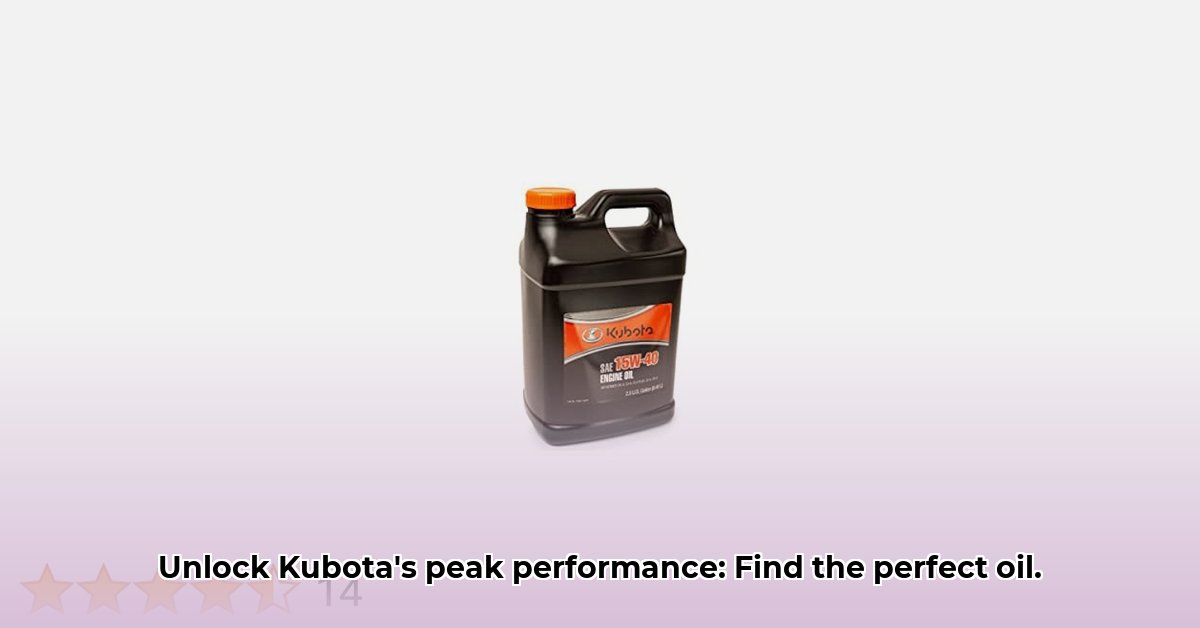
Choosing the right oil for your Kubota tractor is crucial for engine longevity and performance. Conflicting advice online can be confusing, but this guide clarifies the best oil type for your specific needs, considering climate, usage, and storage. We'll break down oil viscosity, Kubota's recommendations, real-world experiences, and provide a step-by-step oil change guide. For more detailed information on Kubota tractor oil filters, check out this helpful resource: Kubota Oil Filters.
Understanding Oil Viscosity: The Key to Engine Health
Oil viscosity refers to its thickness or resistance to flow. This impacts how easily the oil lubricates engine parts at various temperatures. You'll see viscosity grades like 10W-30, 15W-40, and 5W-40. The "W" denotes "winter," indicating its performance in cold temperatures. The number before the "W" represents the oil's viscosity at low temperatures (the lower the number, the better it flows in the cold). The number after the "W" indicates its viscosity at high temperatures (higher numbers mean thicker oil at high temperatures, suitable for hotter climates and heavier workloads).
| Viscosity Grade | Optimal Temperature Range (°F) | Suitable Conditions |
|---|---|---|
| 5W-40 | -20°F to 110°F+ | Extreme temperature variations, heavy use, extended lifespan |
| 10W-30 | 0°F to 95°F+ | Moderate climates, average use |
| 15W-40 | 10°F to 110°F+ | Warmer climates, less extreme temperature swings |
Remember, these ranges are guidelines. Your owner's manual is the final authority.
Kubota's Official Recommendations: Always Check Your Manual!
Kubota provides specific oil recommendations based on your tractor model and year. Always consult your owner's manual before making any oil decisions! Ignoring this crucial step could void your warranty and potentially damage your engine. Don't skip this vital step! It is the most crucial step in this entire process.
Real-World Experiences: Balancing Official Guidance and Practical Use
Many Kubota owners report successfully using 15W-40 year-round, even in areas with mild winters. While not always officially recommended, this practice highlights the interplay between official guidance and practical experience. However, using heavier oil in extremely cold conditions increases the risk of slower oil flow, potentially leading to wear and tear. Understanding the nuances of your climate and usage is key. A heavier oil can be detrimental in cold starts, yet, it can be superior in consistently higher temperatures.
Choosing the Right Oil: A Decision-Making Framework
The best oil for your Kubota depends on several factors:
Climate: Extreme cold requires lower viscosity oils (like 10W-30 or 5W-40 synthetic) for easier cold starts. Warmer climates allow for higher viscosity (15W-40).
Usage: Heavy, frequent use benefits from higher-quality oils capable of enduring greater stress. Lighter, occasional use allows for more flexibility in choice.
Storage: Indoor storage protects against temperature extremes, offering more leeway in oil selection. Outdoor storage requires more careful consideration, prioritizing oils that can handle temperature fluctuations.
Tractor Model and Age: Older models might tolerate slightly thicker oils, but again, always verify with your owner's manual.
Here’s a simplified guide:
| Climate | Usage | Storage | Suggested Oil Type |
|---|---|---|---|
| Cold (Below 0°F) | Light | Indoor | 10W-30 |
| Cold (Below 0°F) | Heavy | Indoor | 5W-40 (Synthetic) |
| Mild (Above 32°F) | Light | Outdoor | 15W-40 |
| Mild (Above 32°F) | Heavy | Outdoor | 5W-40 (Synthetic) |
| Hot (Above 90°F) | Any | Any | 5W-40 (Synthetic) or higher |
Synthetic vs. Conventional Oils: Cost vs. Performance
Conventional oils are generally cheaper but may have shorter lifespans and perform less effectively in extreme temperatures.
Synthetic oils are more expensive, but offer superior performance, longer lifespans, and better protection in extreme conditions. They are generally better for cold and hot weather.
Performing an Oil Change: A Step-by-Step Guide
Warm-up: Run the engine briefly to warm the oil.
Prepare: Position a drain pan under the drain plug.
Drain: Carefully remove the drain plug and let the old oil drain completely.
Filter: Replace the oil filter.
Refill: Add the correct amount of new oil (check your owner's manual).
Check: Verify the oil level using the dipstick.
Frequently Asked Questions (FAQ)
Q: How often should I change my Kubota's oil? A: Refer to your owner's manual for the recommended interval – this varies greatly among models.
Q: What happens if I use the wrong oil? A: Using incorrect oil can harm your engine, leading to decreased performance, increased wear, and costly repairs.
Q: Should I get an oil analysis? A: Oil analysis can detect potential problems early. It's beneficial for tractors that see heavy use.
This guide offers helpful suggestions, but your owner's manual serves as the single most important resource. If you have any doubts, consult a qualified Kubota mechanic. Regular maintenance is paramount—don't neglect your tractor's oil!